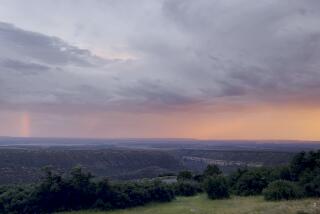Alaska Animal Watch
DENALI NATIONAL PARK, Alaska â âDall sheep, caribou, grizzlies, moose. Those are the Big Four--the hand we want to draw.â
This was Alaska. The speaker was Barbara, our pony-tailed bus driver. It was her seventh summer in Denali National Park, a wild expanse of peaks and tundra that is roughly the size of Massachusetts. Her enthusiasm for the adventure was as fresh as year one.
Barbara picked us up at Harper Lodge, a rustic log beauty on the Nenana River just a mile from the park entrance.
âFirst thing, fasten your seat belts,â she announced.
We did. The park road is graded dirt, 1 1/2 lanes wide. Buses ease past each other on rugged turns.
Barbara brakes for animals. She also brakes for rocks, which is what you see more of than animals in Denali. That is the main lesson in looking for wildlife in this seemingly empty park: look for rocks. When the rocks move, pull out your field glasses.
It is not like viewing the large herds of East Africa. The land is vast. Vegetation is sparse because of harsh winters, 200 miles south of the Arctic Circle. Animal populations are relatively small. Sightings become a game.
Counting Grizzlies
In Denali, a park of 6 million acres, rangers estimate there are 200 grizzlies. âBut thatâs give or take 50,â Barbara said. âItâs difficult to count grizzlies because they roam over large territories in a 24-hour period. Itâs hard to know if itâs the same one you counted earlier.â
And they resemble bleached rocks.
The grizzlies of Kodiak Island are more obviously bears. They are dark brown and weigh 1,200 pounds. The grizzlies in Denali are smaller, maybe 600 pounds. And they are as blond as straw.
Barbara, whose college major was philosophy, preached gently to us as we ate box lunches and waited for the animals to appear. She talked of the 17 types of willows that grow in the park, and spun tales of glacial streams. She waxed on about moons and Northern Lights and the beauty of dwarf rhododendron.
Before our first rest stop she gave a short warning:
âEncounters with bears are rare, but never run from a grizzly. Theyâll chase anything that runs. Remember, they can smell you before they see you. So stand still and look as tall as you can, and then raise your arms over your head and out to the side and wiggle them fast. Hold your ground. Speak to them. Say, âHi, Iâm Joe. Howâs it going?â â
Baffled, Then Bored
Barbaraâs theory is that such behavior will baffle the beasts and they will lose interest. She said sheâs never heard of a moose or caribou acting like that, so the bear should not mistake you for prey.
She insisted that a Denali grizzlyâs diet is about 70% vegetarian. They have no salmon, unlike their Kodiak cousins. They gorge on roots and berries.
âSure, they play chase with ground squirrels,â she added, âand when they catch one itâs like a vitamin tablet. Thereâs a two-week chance for protein in the spring when the moose drop their young. But thatâs it. Grizzlies donât really go for people, unless you startle them and run.â
I practiced saying, âHi, Iâm Joe.â
Three hours into the park, Barbara eased the bus to a halt. She thought she saw a grizzly. It was far down a slope, near a kettle pond. I pulled out binoculars.
While we were debating whether it was a bear or a boulder, the road was suddenly wrapped in a rainbow, a gaudy arch against the tan, raw land. That is part of the wonder of Denali, the counterpoint of grand and comic: the lone caribou on a bald knoll who pretends heâs not there; the feisty young gull who poses by the road, the flocks of Dall sheep that cling to sheer slopes like wet sheets blown into a wall.
It was, indeed, a grizzly. He lumbered off into the woods. Vegetation shrinks as the mountains grow. Spruce turn into pygmy forests, and finally disappear.
Mt. McKinley--Sometimes
Above it all, or so I was told, rises Mt. McKinley, at 20,320 feet.
âIf we could see it today it would be right there,â Barbara said softly, pointing at a majestic, cloud-filled gap. âOnly 20% of our visitors are lucky enough to see the mountain from the road. Itâs shrouded 75% of the time.
âBut did you know that it has the greatest vertical free-rise in the world? Mt. Everest is about 10,000 feet straight up, but McKinley is over 18,000 feet from base to summit. Weâre talking a big mountain. On a clear day you can see it from Anchorage.â
Denali, meaning âhigh one,â is the name given McKinley by Alaska Indians. This was Mt. McKinley National Park before its enlargement and name change in 1980.
After seven hours on the lone loop road we returned to Harper Lodge. Weâd seen two grizzlies, some caribou and sheep.
âIâm sorry you didnât get to see a moose,â Barbara said, âbut you did get a grizzly. If we get skunked on one of the Big Four, itâs usually a grizzly.â
I walked out on the sun-dappled deck where backpackers were soaking in hot tubs at 10 p.m. They said their helicopter flight around McKinley was spectacular. I stared at the golden ribbon of the Nenana River, with its green banks of birch and spruce.
Far off, something moved. It was a moose. He raised his antlers, as if to be counted.
More to Read
Sign up for The Wild
Weâll help you find the best places to hike, bike and run, as well as the perfect silent spots for meditation and yoga.
You may occasionally receive promotional content from the Los Angeles Times.






